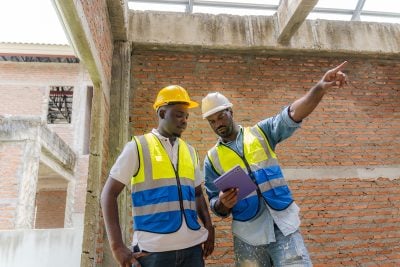On 11 September, in the early hours of the morning, a wall of water tore through the port city of Derna in eastern Libya, destroying everything in its path. Entire neighbourhoods were swept into the Mediterranean Sea. Over 4,000 deaths had been confirmed a month later, with more than 8,500 people still missing.
The immediate cause of the disaster was exceptionally intense rainfall as Storm Daniel battered the region. Two dams on rivers upstream of Derna were overwhelmed by the volume of water and collapsed, releasing a deadly torrent that cascaded into the city.
But the scale of the damage reflects the failure to ensure that Libya’s infrastructure could cope with extreme events. Authorities in the war-torn country had been unable or unwilling to ensure the dams were properly maintained, despite repeated warnings over their condition over the last 25 years.
The vulnerability of critical infrastructure is certainly not unique to Libya. “Currently, Africa’s infrastructure, especially in the more frontier countries, is not adequately protected from climate shocks,” says Chris Chijiutomi, managing director and head of Africa at British International Investment, the UK’s development finance institution.
“Infrastructure in Africa remains underdeveloped,” he warns, “and therefore it’s difficult for it to withstand some of the shocks associated with climate change.”
Related articles
- ‘Africa is the solution for global net zero’
- Escalation in climate disasters make ‘Loss and Damage’ fund more urgent
- African solutions gather pace in energy infrastructure investment
The coming storm
There is little doubt that tragedies like Derna will be repeated. Around the world, extreme weather is on the rise as climate change accelerates. Floods, storms, droughts, landslides and wildfires are all becoming more frequent and more intense.
The flooding in Derna is just one of the many climate-related disasters to have struck Africa over the last year. Algeria was ravaged by wildfires over the summer. Over one thousand people were killed when Cyclone Freddy hit Mozambique and Malawi in March, while several hundred died in flooding in the Democratic Republic of Congo and Rwanda in January.
Meanwhile, the extensive damage from an earthquake on 8 September in Morocco is partly the result of poor construction techniques and the lax enforcement of building regulations. Over 3,000 people are known to have been killed by the tremors.
Chijiutomi tells us that the increased likelihood of extreme events means that infrastructure planners need to re-evaluate their assumptions. Flood events that might have been expected once every 100 years might now be likely every 10 years, for example. “You have to look at how you design the infrastructure to cope with that,” he says, noting that reinforcing infrastructure is likely to entail increased capital costs, or result in alternative technologies being used.
Data dilemmas
Tania Swanepoel, head of Environmental, Social, Governance (ESG) at Africa Infrastructure Investment Managers, agrees that there is an urgent need to understand the kind of risks that infrastructure needs to be able to cope with in a world where the future climate looks markedly different. “The top priority for improving climate resilience in African infrastructure is to assess risks of physical damage associated with climate change,” she says.
“Factoring climate change risks, impact and opportunities early in the design phase of engineering projects, and integrating them into project planning from the start, rather than as a bolt-on added later, is essential.”
Yet assessing the risks to infrastructure is not straightforward, partly because the sophisticated modelling required to assess physical climate risks does not always make its way into the right hands.
“The greatest gap is access to useful climate data, which can be used as a solid basis for creating or developing climate resilient infrastructure,” says Romanus Otieno Opiyo, programme lead for sustainable urbanisation at non-profit research group SEI Africa. Part of the problem, he says, is that government departments often work in silos and fail to share data, leading to “a lot of disjointed effort”.
On top of this, Opiyo says that consultants that are parachuted into infrastructure projects often fail to listen to “indigenous knowledge”. He cites examples in Lusaka and Kampala, where local people were aware that roads were being built in locations vulnerable to flooding, “but nobody bothered to ask them” before launching into construction – with predictable consequences.
Maintenance concerns
Along with poor design and planning, another obvious problem is the lack of attention given to prevention and maintenance.
Ensuring the resilience of infrastructure is normally “not given a high priority” by politicians who are preoccupied by seemingly more pressing demands, says Opiyo. Only when disaster strikes is the need for resilience recognised. “During emergencies or during a crisis, you find everybody running around trying to get some emergency funds to deal with this.”
In South Africa, for example, the risk of water shortages around Cape Town was overlooked by local and national government for many years, before a drought caused a severe water crisis in 2017 and 2018. The city was only narrowly able to escape the infamous “Day Zero”, when household water supplies would cease.
Just a few years later, another major South African city is facing a water crisis, casting doubt on whether lessons from Cape Town’s fiasco have been learnt. This time it is Johannesburg where water is running out. Long-term underfunding and the failure to repair leaky water infrastructure has seen piped water supplies run dry in parts of the city, forcing the water utility to supply residents using tankers.
Meanwhile, as the Derna disaster demonstrated, failing to maintain dams can have catastrophic consequences. But this does not mean governments necessarily prioritise dam maintenance, especially in countries suffering from prolonged economic problems. For example, there have been repeated warnings over the past decade that the Kariba Dam on the Zambia-Zimbabwe border is at risk of collapse if water levels rise excessively (the dam has also suffered the opposite problem, with low rainfall shutting down electricity generation late last year).
Opiyo notes that the lack of maintenance is a “major problem” in most African countries. Infrastructure projects are often pushed by outside actors; once construction is complete, governments typically fail to allocate funds for maintenance, he laments.
More positively, Opiyo says that some governments, such as those in Kenya and Rwanda, are taking maintenance more seriously, while multilateral and bilateral development organisations are requiring improved risk and hazard analysis as a condition of funding.
Chijiutomi adds that the private sector can play a bigger role in financing climate-resilient infrastructure. “If we’re going to move the needle around increasing the ability of the infrastructure stock to be able to withstand climate shocks, then there needs to be more public-private collaboration in this space,” he says.
“I think the private sector is willing to help play a role, but it needs to understand the allocation of risks, in terms of the risks it can take and manage and mitigate where possible, versus the risks the public sector is better placed to deal with and manage,” says Chijiutomi.
Waking up to resilience
Aurélien Pillet, senior climate finance specialist at the non-profit Basel Agency for Sustainable Energy (BASE), emphasises that a key way to boost climate resilience is to focus on decentralising infrastructure. A facility that has its own supply of energy, for example, is less vulnerable to climate shocks that could affect national-level systems or supply chains.
As such, BASE is a partner in a scheme to scale up the use of cold storage rooms for agricultural products. The electricity needed for cooling these facilities is provided through solar panels, rather than diesel generators.
“Investing in decentralised solar power cold storage rooms will basically break the dependency on importing fuels that are usually needed to generate electricity through diesel generators,” says Pillet. “In the context of climate adaptation, you will adapt better to potential natural disasters because the supply chain of importing your inputs, your feedstock, to generate electricity at the cold storage room level will not be disrupted.”
Similarly, BASE is seeking to promote solar power at healthcare facilities. Solar, combined with battery storage, could supplement power from the grid, or function as an entirely independent system.
“The decentralisation aspect is also extremely important to avoid failures at the grid level,” says Pillet. With a reliable energy source, he says, clinics can be more resilient to natural disasters and function as “essential hubs for disaster response” that allow vital services to continue running, he says.
Like Opiyo, Pillet is optimistic that progress is being made in integrating climate resilience into the design of new infrastructure projects, particularly where donor financing is involved. Climate adaptation, he tells us, has “really become a priority” for development organisations, who “systematically” expect developers to design infrastructure with climate adaptation in mind. Donors are also supporting African governments in improving their policy framework for climate resilience, he adds.
For the hundreds of millions of people in Africa that are exposed to climate shocks, efforts to strengthen infrastructure cannot come a moment too soon. The reality is thousands of lives have been lost in Africa in 2023 alone because the continent’s infrastructure is not resilient in the face of natural disasters. The urgent need to reinforce the continent’s infrastructure to cope with climate change can no longer be ignored.
Want to continue reading? Subscribe today.
You've read all your free articles for this month! Subscribe now to enjoy full access to our content.
Digital Monthly
£8.00 / month
Receive full unlimited access to our articles, opinions, podcasts and more.
Digital Yearly
£70.00 / year
Our best value offer - save £26 and gain access to all of our digital content for an entire year!

 Sign in with Google
Sign in with Google 



